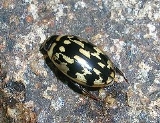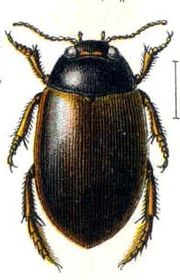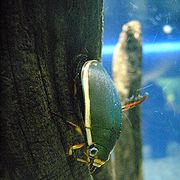
Dytiscidae
Encyclopedia
Dytiscidae – based on the Greek dytikos (δυτικός), "able to dive" – are the predaceous diving beetles, a family
of water beetle
s. They are about 25 mm (one inch) long on average, though there is much variation between species
. Dytiscus latissimus
, the largest, can grow up to 45 mm long. Most are dark brown, blackish or dark olive in color with golden highlights in some subfamilies. They have short, but sharp mandible
s. Immediately upon biting they deliver digestive enzymes. The larva
e are commonly known as water tigers. The family has not been comprehensively cataloged since 1920, but is estimated to include about 4,000 species
in over 160 genera
.
s and glassworm
s, among dozens of other smaller water-dwelling creatures.
As soon as the beetles come to the stage in life in which they mature to adulthood, the larva crawl from the water on the sturdy legs, and bury themselves in the mud for pupation. After about a week, or longer in some species, they emerge from the mud as adults.
, are edible
. In Mexico
, C. explanatus are eaten roasted and salted to accompany taco
s. In Japan, C. japonicus
is used as food. In the Guangdong Province of China
, the latter species as well as C. bengalensis, C. guerini, C. limbatus, C. sugillatus, C. tripunctatus and probably also the well-known Great Diving Beetle Dytiscus marginalis are bred for human consumption, though as they are cumbersome to raise due to the carnivorous habit and have a fairly bland (though apparently not offensive) taste and little meat, this is decreasing. Dytiscidae are reportedly also eaten in Taiwan
, Thailand
, and New Guinea
.
Large but slow on land and not particularly fierce as adults, they are also eaten with relish by many mid-sized bird
s, mammal
s and other larger predators. The larvae are usually safer, due to their camouflage
and ability to escape by water jet; they can be quite hard to catch and may become apex predator
s in small pond
s.
s, and some notable genera
. Note that the Colymbetinae are heavily split up in many treatments, and their monophyly
if widely delimited is in doubt.
Subfamily Aubehydrinae
Subfamily Copelatinae
Subfamily Agabetinae
Subfamily Laccophilinae
Subfamily Hydroporinae


Subfamily Colymbetinae

Subfamily Dytiscinae

Family (biology)
In biological classification, family is* a taxonomic rank. Other well-known ranks are life, domain, kingdom, phylum, class, order, genus, and species, with family fitting between order and genus. As for the other well-known ranks, there is the option of an immediately lower rank, indicated by the...
of water beetle
Water beetle
A water beetle is a beetle adapted to living in water. Water beetles rise to the water surface and take atmospheric air into their tracheal systems. There are approximately 2000 species of water beetles. The rest marine species tend to live in the intertidal zone...
s. They are about 25 mm (one inch) long on average, though there is much variation between species
Species
In biology, a species is one of the basic units of biological classification and a taxonomic rank. A species is often defined as a group of organisms capable of interbreeding and producing fertile offspring. While in many cases this definition is adequate, more precise or differing measures are...
. Dytiscus latissimus
Dytiscus latissimus
Dytiscus latissimus is a species of beetle in family Dytiscidae. It is found in Austria, Belarus, Belgium, Bosnia and Herzegovina, Croatia, the Czech Republic, Denmark, Estonia, Finland, France, Germany, Hungary, Italy, Latvia, Lithuania, Luxembourg, the Netherlands, Norway, Poland, Romania,...
, the largest, can grow up to 45 mm long. Most are dark brown, blackish or dark olive in color with golden highlights in some subfamilies. They have short, but sharp mandible
Mandible (insect)
Insect mandibles are a pair of appendages near the insect’s mouth, and the most anterior of the three pairs of oral appendages . Their function is typically to grasp, crush, or cut the insect’s food, or to defend against predators or rivals...
s. Immediately upon biting they deliver digestive enzymes. The larva
Larva
A larva is a distinct juvenile form many animals undergo before metamorphosis into adults. Animals with indirect development such as insects, amphibians, or cnidarians typically have a larval phase of their life cycle...
e are commonly known as water tigers. The family has not been comprehensively cataloged since 1920, but is estimated to include about 4,000 species
Species
In biology, a species is one of the basic units of biological classification and a taxonomic rank. A species is often defined as a group of organisms capable of interbreeding and producing fertile offspring. While in many cases this definition is adequate, more precise or differing measures are...
in over 160 genera
Genera
Genera is a commercial operating system and development environment for Lisp machines developed by Symbolics. It is essentially a fork of an earlier operating system originating on the MIT AI Lab's Lisp machines which Symbolics had used in common with LMI and Texas Instruments...
.
Larvae and development
When still in larval form, the beetles vary in size from about 1 to 5 cm (half an inch to two inches). The larvae's bodies are shaped like crescents, with the tail long and covered with thin hairs. Six legs protrude from along the belly, which also sports the same thin hairs. The head is flat and square, with a pair of long, large pincers. When hunting, they cling to grasses or pieces of wood along the bottom, and hold perfectly still until prey passes by, then they lunge, trapping their soon-to-be-food between their front legs and biting down with its pincers. Their usual prey includes tadpoleTadpole
A tadpole or polliwog is the wholly aquatic larval stage in the life cycle of an amphibian, particularly that of a frog or toad.- Appellation :...
s and glassworm
Glassworm
A glassworm is a type of midge larva called Chaoborus. They are also known as phantom midge larvae, because they are transparent. They can be found commonly in lakes all over the world and can be up to 2 centimeters in length....
s, among dozens of other smaller water-dwelling creatures.
As soon as the beetles come to the stage in life in which they mature to adulthood, the larva crawl from the water on the sturdy legs, and bury themselves in the mud for pupation. After about a week, or longer in some species, they emerge from the mud as adults.
Edibility
Adult Dytiscidae, particular of the genus CybisterCybister
Cybister , is a genus of beetle in family Dytiscidae native to the Old World, North America, and Australia. There are approximately 80 species in the genus.-External links:**...
, are edible
Entomophagy
Entomophagy is the consumption of insects as food. Insects are eaten by many animals, but the term is generally used to refer to human consumption of insects; animals that eat insects are known as insectivores...
. In Mexico
Mexico
The United Mexican States , commonly known as Mexico , is a federal constitutional republic in North America. It is bordered on the north by the United States; on the south and west by the Pacific Ocean; on the southeast by Guatemala, Belize, and the Caribbean Sea; and on the east by the Gulf of...
, C. explanatus are eaten roasted and salted to accompany taco
Taco
A taco is a traditional Mexican dish composed of a corn or wheat tortilla folded or rolled around a filling. A taco can be made with a variety of fillings, including beef, chicken, seafood, vegetables and cheese, allowing for great versatility and variety...
s. In Japan, C. japonicus
Cybister japonicus
Cybister japonicus is a species of beetle native to Asia....
is used as food. In the Guangdong Province of China
China
Chinese civilization may refer to:* China for more general discussion of the country.* Chinese culture* Greater China, the transnational community of ethnic Chinese.* History of China* Sinosphere, the area historically affected by Chinese culture...
, the latter species as well as C. bengalensis, C. guerini, C. limbatus, C. sugillatus, C. tripunctatus and probably also the well-known Great Diving Beetle Dytiscus marginalis are bred for human consumption, though as they are cumbersome to raise due to the carnivorous habit and have a fairly bland (though apparently not offensive) taste and little meat, this is decreasing. Dytiscidae are reportedly also eaten in Taiwan
Taiwan
Taiwan , also known, especially in the past, as Formosa , is the largest island of the same-named island group of East Asia in the western Pacific Ocean and located off the southeastern coast of mainland China. The island forms over 99% of the current territory of the Republic of China following...
, Thailand
Thailand
Thailand , officially the Kingdom of Thailand , formerly known as Siam , is a country located at the centre of the Indochina peninsula and Southeast Asia. It is bordered to the north by Burma and Laos, to the east by Laos and Cambodia, to the south by the Gulf of Thailand and Malaysia, and to the...
, and New Guinea
New Guinea
New Guinea is the world's second largest island, after Greenland, covering a land area of 786,000 km2. Located in the southwest Pacific Ocean, it lies geographically to the east of the Malay Archipelago, with which it is sometimes included as part of a greater Indo-Australian Archipelago...
.
Large but slow on land and not particularly fierce as adults, they are also eaten with relish by many mid-sized bird
Bird
Birds are feathered, winged, bipedal, endothermic , egg-laying, vertebrate animals. Around 10,000 living species and 188 families makes them the most speciose class of tetrapod vertebrates. They inhabit ecosystems across the globe, from the Arctic to the Antarctic. Extant birds range in size from...
s, mammal
Mammal
Mammals are members of a class of air-breathing vertebrate animals characterised by the possession of endothermy, hair, three middle ear bones, and mammary glands functional in mothers with young...
s and other larger predators. The larvae are usually safer, due to their camouflage
Crypsis
In ecology, crypsis is the ability of an organism to avoid observation or detection by other organisms. It may be either a predation strategy or an antipredator adaptation, and methods include camouflage, nocturnality, subterranean lifestyle, transparency, and mimicry...
and ability to escape by water jet; they can be quite hard to catch and may become apex predator
Apex predator
Apex predators are predators that have no predators of their own, residing at the top of their food chain. Zoologists define predation as the killing and consumption of another organism...
s in small pond
Pond
A pond is a body of standing water, either natural or man-made, that is usually smaller than a lake. A wide variety of man-made bodies of water are classified as ponds, including water gardens, water features and koi ponds; all designed for aesthetic ornamentation as landscape or architectural...
s.
Systematics
The following taxonomic sequence gives the subfamilies, their associated tribeTribe (biology)
In biology, a tribe is a taxonomic rank between family and genus. It is sometimes subdivided into subtribes.Some examples include the tribes: Canini, Acalypheae, Hominini, Bombini, and Antidesmeae.-See also:* Biological classification* Rank...
s, and some notable genera
Genera
Genera is a commercial operating system and development environment for Lisp machines developed by Symbolics. It is essentially a fork of an earlier operating system originating on the MIT AI Lab's Lisp machines which Symbolics had used in common with LMI and Texas Instruments...
. Note that the Colymbetinae are heavily split up in many treatments, and their monophyly
Monophyly
In common cladistic usage, a monophyletic group is a taxon which forms a clade, meaning that it contains all the descendants of the possibly hypothetical closest common ancestor of the members of the group. The term is synonymous with the uncommon term holophyly...
if widely delimited is in doubt.
Subfamily Aubehydrinae
- Notaticus
Subfamily Copelatinae
- Agaporomorphus
- Aglymbus
- CopelatusCopelatusCopelatus is a large genus of small diving beetles. There are some 470 described species in the genus, found worldwide, but they are most diverse in tropical South America, Africa and South-East Asia.-Systematics:...
- Lacconnectus
- Madaglymbus
Subfamily Agabetinae
- Agabetes
Subfamily Laccophilinae
- LaccophilusLaccophilusLaccophilus is a genus of water beetle found in nearly every temperate or tropical region in the world including but not limited to Europe, the Near East, the Nearctic, North Africa and the Oriental region.-External links:*...
- Laccodytes
Subfamily Hydroporinae

- Tribe Laccornini
- Laccornis
- Tribe Vatellini
- Derovatellus
- Macrovatellus
- Mesovatellus
- Vatellus
- Tribe Methlini
- Celina
- Methles
- Tribe Hydrovatini
- Hydrovatus
- Queda
- Tribe Hyphydrini
- Desmopachria
- HyphydrusHyphydrusHyphydrus is a genus of diving beetle native to the Palearctic , the Afro-tropical region, the Near East, North Africa.-External links:*...
- Pachydrus
- Tribe Bidessini
- Allodessus
- Bidessus
- Guignotus

- Tribe Hydroporini
- Coelambus
- DeronectesDeronectesDeronectes is a genus of beetle in family Dytiscidae. It contains the following species:* Deronectes addendus* Deronectes algibensis* Deronectes angelinii* Deronectes angusi* Deronectes aubei* Deronectes bicostatus...
- GraptodytesGraptodytesGraptodytes is a genus of beetles in family Dytiscidae. It contains the following species:* Graptodytes aequalis* Graptodytes atlantis* Graptodytes bilineatus* Graptodytes castilianus* Graptodytes concinnus...
- Heterosternuta
- HydroporusHydroporusHydroporus is a genus of water beetle native to the Palearctic , the Nearctic, the Near East, and North Africa.-External links:*...
(including HydrotarsusHydrotarsusHydrotarsus is a genus of beetle in family Dytiscidae. Many include it in Hydroporus today.Species include:* Hydrotarsus compunctus* Hydrotarsus pilosus...
) - HygrotusHygrotusHygrotus is a genus of beetle in family Dytiscidae. It contains two subgenera and about 70 species, including:* Hygrotus acaroides* Hygrotus artus* Hygrotus caspius* Hygrotus chinensis...
- Nebrioporus
- Neonectes
- NeoporusNeoporusNeoporus is a genus of beetle in the family Dytiscidae. These are the predaceous diving beetles, a family of water beetles. Their larvae are commonly known as water tigers. Neoporus is one of over 160 genera in family Dytiscidae.- Species :...
- Oreodytes
- Porhydrus
- Siettitia
- Stictotarsus
Subfamily Colymbetinae

- Tribe Agabini (sometimes considered a subfamily Agabinae)
- Agabinus
- AgabusAgabus (beetle)Agabus is a large genus of predatory aquatic beetles in the family Dytiscidae, proposed in 1817 by William Elford Leach and named after Agabus, an early follower of Christianity. The adult beetles are moderate-sized, 5 to 14 mm long. The genus is primarily Holarctic in distribution, with only...
- Agametrus
- Andonectes
- Gaurodites
- Hydrotrupes
- Ilybiosoma
- PlatambusPlatambusPlatambus is a genus of beetle native to the Palearctic, including Europe, the Near East and North Africa. It destingushed by a wide epipleuron. Ventral body part, as a fact, has spot marking.-External links:*...
- Tribe Coptotomini (sometimes considered a subfamily Coptotominae)
- Coptotomus
- Tribe Matini (sometimes considered a subfamily Matinae)
- Allomatus
- Batrachomatus
- MatusMatusMatus is a genus of beetle in family Dytiscidae. It contains the following species:* Matus bicarinatus* Matus leechi* Matus ovatus* Matus relictus* Matus levifailus...
- Tribe Colymbetini
- Carabdytes
- ColymbetesColymbetesColymbetes is a genus of beetle native to the Palearctic, including Europe, the Nearctic, the Near East and North Africa.-External links:*...
- Hoperius
- IlybiusIlybiusIlybius is a large genus of predatory aquatic beetles in the family Dytiscidae. The genus is native to the Palearctic , the Near East, the Nearctic, and North Africa. 70 species has been described from this genus.-External links:*...
- RhantusRhantusRhantus is a genus of beetle in family Dytiscidae.-Species:* Rhantus aequalis Hatch* Rhantus alutaceus* Rhantus anisonychus Crotch* Rhantus atricolor Aube* Rhantus binotatus Harris* Rhantus bistriatus Bergstrom...
Subfamily Dytiscinae

- Tribe Dytiscini
- DytiscusDytiscusDytiscus is a Holarctic genus of predaceous diving beetles that usually live in wetlands and ponds. There are 26 species in this genus distributed in Europe, Asia, North Africa and North and Central America...
- Hyderodes
- Dytiscus
- Tribe Hydaticini
- HydaticusHydaticusHydaticus is a genus of predatory water beetle belonging to the family Dytiscidae, native to the Palearctic , the Afro-tropical region, the Near East, the Nearctic and North Africa.-External links:*...
- Hydaticus
- Tribe Aciliini
- AciliusAcilius (genus)Acilius is a holarctic genus of diving beetles. It contains the following species:*Acilius abbreviatus*Acilius athabascae*Acilius brevis*Acilius canaliculatus*Acilius confusus*Acilius duvergeri*Acilius fasciatus...
- GraphoderusGraphoderusGraphoderus is a genus of beetle in family Dytiscidae native to the Palearctic, including Europe, and the Near East.-External links:*...
- Sandracottus
- ThermonectusThermonectusThermonectus is a genus of beetle in family Dytiscidae. This genus is native to the New World, and mainly from warm temperate to tropical in distribution, but one species, T. basilaris occurs as far north as southern Ontario, Canada.-External links:...
- Acilius
- Tribe Eretini
- EretesEretesEretes is a genus of beetle in family Dytiscidae consisting of 4 species. The genus is native to the Afro-tropical region, the Palearctic , the Near East, North Africa and the Asian region.-External links:**...
- Eretes
- Tribe Cybistrini
- Austrodytes
- CybisterCybisterCybister , is a genus of beetle in family Dytiscidae native to the Old World, North America, and Australia. There are approximately 80 species in the genus.-External links:**...
- MegadytesMegadytesMegadytes is a mainly Neotropical genus of large diving beetles in family Dytiscidae. It contains the following species:* Megadytes australis* Megadytes carcharias* Megadytes ducalis* Megadytes fallax* Megadytes fraternus...
- Onychohydrus
- Sternhydrus

